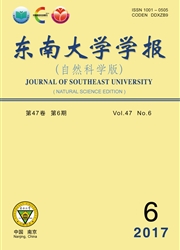

 中文摘要:
中文摘要:
为了提高认知无线网络的丢包率和吞吐量性能,运用基于学习策略的动态频谱接入方法感知授权信道.在已知主用户先验信息的条件下,认知用户根据主用户信号忙闲的统计特性,按照空闲状态概率从高到低的顺序依次对目标授权信道进行频谱感知,并接入第1个检测到的空闲信道.针对固定速率和可变速率2种业务类型,分别考察了认知无线网络的丢包率和吞吐量性能.在未知主用户先验统计特性的条件下,认知用户的平均错误预测概率直接影响着系统性能.仿真结果表明,与随机频谱感知性能相比,基于机器学习和预测的频谱感知的丢包率和吞吐量性能均有所提高.认知用户基于学习策略的动态频谱接入信道选择方法可以有效利用频谱空穴,提高系统频带利用率.
 英文摘要:
英文摘要:
To improve the performances of packet loss rate and throughput in cognitive radio network,an approach for learning-based dynamic spectrum access is put forward for spectrum sensing.A channel selection scheme is proposed under the condition that the priori information of primary user is known.Based on the idle and busy state statistical properties of the primary user signal,secondary user performs sensing on the objective licensed channel in accordance with the vacancy state probability in descending order,and then accesses to the first channel detected to be idle.For the fixed rate and variable rate services,the performances of packet loss rate and throughput of cognitive radio network are analyzed.As for the channel selection scheme in the case of the unknown priori information to the secondary user,the system performances are influenced by the mean probability of error prediction.Simulation results show that the proposed dynamic spectrum access scheme based on learning and prediction achieves better performances in packet loss rate and throughput than the random spectrum sensing.Learning-based channel selection of dynamic spectrum access can exploit spectrum holes efficiently and improve the channel utilization in cognitive radio systems.
 同期刊论文项目
同期刊论文项目
 同项目期刊论文
同项目期刊论文
 Resource allocation for the OFDM-based cognitive radio system with heterogeneous delay-constraint tr
Resource allocation for the OFDM-based cognitive radio system with heterogeneous delay-constraint tr A novel signal separation algorithm based on compressed sensing for wideband spectrum sensing in cog
A novel signal separation algorithm based on compressed sensing for wideband spectrum sensing in cog Analysis of the Coverage Probability in Femtocell Networks Locating in Cell Center and Cell Edge Bas
Analysis of the Coverage Probability in Femtocell Networks Locating in Cell Center and Cell Edge Bas Spatial-temporal opportunity detection in spectrum-heterogeneous cognitive radio networks : Two-dime
Spatial-temporal opportunity detection in spectrum-heterogeneous cognitive radio networks : Two-dime Stealthy Attacker Detection with Multi-Dimensional Feature Vector for Collaborative Spectrum Sensing
Stealthy Attacker Detection with Multi-Dimensional Feature Vector for Collaborative Spectrum Sensing Opportunistic spectrum access in unknown dynamic environment: A game-theoretic stochastic learning s
Opportunistic spectrum access in unknown dynamic environment: A game-theoretic stochastic learning s Opportunistic spectrum access in cognitive radio networks: Global optimization using local interacti
Opportunistic spectrum access in cognitive radio networks: Global optimization using local interacti Joint spectrum sensing and transmit power adaptation for interference-aware cognitive radio networks
Joint spectrum sensing and transmit power adaptation for interference-aware cognitive radio networks Distributed Channel Selection in CRAHNs with Heterogeneous Spectrum Opportunities: A Local Congestio
Distributed Channel Selection in CRAHNs with Heterogeneous Spectrum Opportunities: A Local Congestio A Connected Dominating Set Based Fast Decentralized Cooperative Sensing Algorithm for Cognitive Radi
A Connected Dominating Set Based Fast Decentralized Cooperative Sensing Algorithm for Cognitive Radi Opportunistic spectrum access using partially overlapping channels: Graphical game and uncoupled lea
Opportunistic spectrum access using partially overlapping channels: Graphical game and uncoupled lea Decision-Theoretic Distributed Channel Selection for Opportunistic Spectrum Access: Strategies, Chal
Decision-Theoretic Distributed Channel Selection for Opportunistic Spectrum Access: Strategies, Chal Consensus-based decentralized clustering for cooperative spectrum sensing in cognitive radio network
Consensus-based decentralized clustering for cooperative spectrum sensing in cognitive radio network Distributed channel selection in time-varying radio environment: Interference mitigation game with u
Distributed channel selection in time-varying radio environment: Interference mitigation game with u 期刊信息
期刊信息
